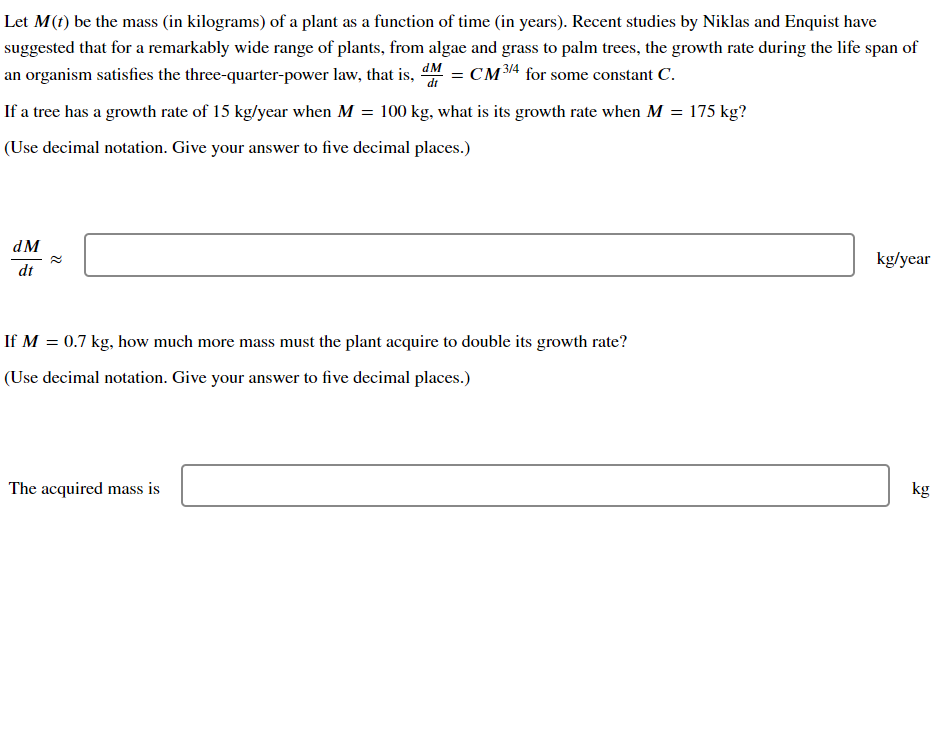Let M(t) be the mass (in kilograms) of a plant as a function of time (in years). Recent studies by Niklas and Enquist have suggested that for a remarkably wide range of plants, from algae and grass to palm trees, the growth rate during the life span of an organism satisfies the three-quarter-power law, that is, M = CM3/4 for some constant C. di If a tree has a growth rate of 15 kg/year when M = 100 kg, what is its growth rate when M = 175 kg? (Use decimal notation. Give your answer to five decimal places.) dM kg/year dt If M = 0.7 kg, how much more mass must the plant acquire to double its growth rate? (Use decimal notation. Give your answer to five decimal places.) The acquired mass is kg
Let M(t) be the mass (in kilograms) of a plant as a function of time (in years). Recent studies by Niklas and Enquist have suggested that for a remarkably wide range of plants, from algae and grass to palm trees, the growth rate during the life span of an organism satisfies the three-quarter-power law, that is, M = CM3/4 for some constant C. di If a tree has a growth rate of 15 kg/year when M = 100 kg, what is its growth rate when M = 175 kg? (Use decimal notation. Give your answer to five decimal places.) dM kg/year dt If M = 0.7 kg, how much more mass must the plant acquire to double its growth rate? (Use decimal notation. Give your answer to five decimal places.) The acquired mass is kg
Chapter6: Exponential And Logarithmic Functions
Section6.1: Exponential Functions
Problem 57SE: Repeat the previous exercise to find the formula forthe APY of an account that compounds daily....
Related questions
Question
Let M(t) be the mass (in kilograms) of a plant as a function of time (in years). Recent studies by Niklas and Enquist have suggested that for a remarkably wide range of plants, from algae and grass to palm trees, the growth rate during the life span of an organism satisfies the three‑quarter‑power law, that is, Mdt=CM^3/4 for some constant C.
If a tree has a growth rate of 15 kg/year when kg, M=100 kg, what is its growth rate when M=175 kg?
(Use decimal notation. Give your answer to five decimal places.)

Transcribed Image Text:Let M(t) be the mass (in kilograms) of a plant as a function of time (in years). Recent studies by Niklas and Enquist have
suggested that for a remarkably wide range of plants, from algae and grass to palm trees, the growth rate during the life span of
an organism satisfies the three-quarter-power law, that is, M = CM3/4 for some constant C.
If a tree has a growth rate of 15 kg/year when M = 100 kg, what is its growth rate when M = 175 kg?
(Use decimal notation. Give your answer to five decimal places.)
dM
kg/year
dt
If M = 0.7 kg, how much more mass must the plant acquire to double its growth rate?
(Use decimal notation. Give your answer to five decimal places.)
The acquired mass is
kg
Expert Solution
This question has been solved!
Explore an expertly crafted, step-by-step solution for a thorough understanding of key concepts.
This is a popular solution!
Trending now
This is a popular solution!
Step by step
Solved in 2 steps with 2 images

Recommended textbooks for you



Algebra & Trigonometry with Analytic Geometry
Algebra
ISBN:
9781133382119
Author:
Swokowski
Publisher:
Cengage



Algebra & Trigonometry with Analytic Geometry
Algebra
ISBN:
9781133382119
Author:
Swokowski
Publisher:
Cengage

Trigonometry (MindTap Course List)
Trigonometry
ISBN:
9781337278461
Author:
Ron Larson
Publisher:
Cengage Learning